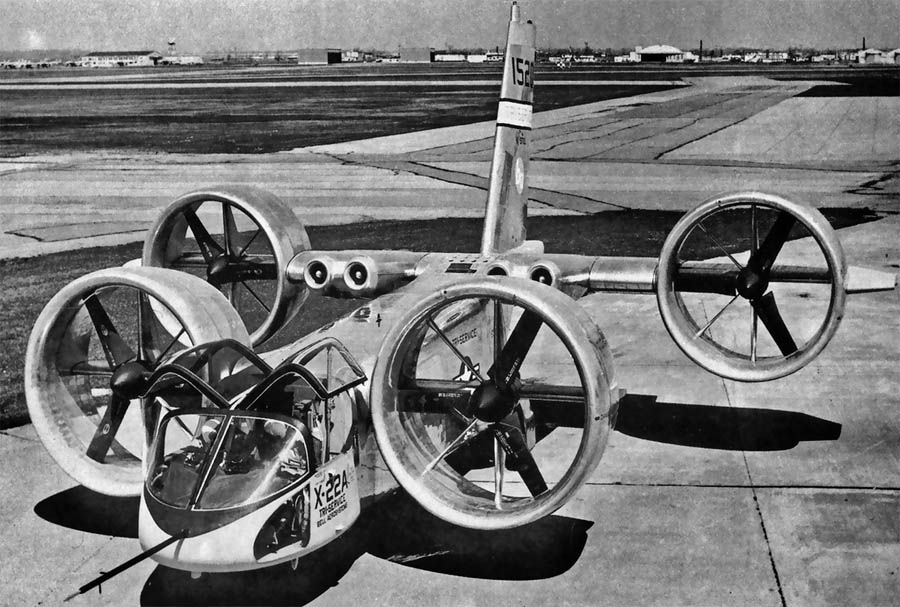 "QUANTUM SHOT" #202(rev) "QUANTUM SHOT" #202(rev) Link - article by Erlend Aaseth and Avi Abrams A vertical takeoff, level flight and a tail landing - first VTOL concepts These flying wonders, so called "Tailsitter" airplanes, are truly remarkable pieces of aviation history: mainly designed in the late 1940s and early 1950s, they were essentially an early attempt to eliminate the necessity of runways.  (Photographs are courtesy U.S. Navy and U.S. Federal Government, via) In the later stages of WWII the German company Focke Wulf came up with a spectacular design for a tailsitting fighter: the Triebflügeljäger. The idea was to create an airplane that would take off and land vertically on its tail. With the Allied bombardment devastating the country's armaments industry it was crucial for the Germans to have interceptors that could take off and protect German factories on a short notice. The idea was to station fighters near industrial areas and to get them into the air without the use of increasingly bombarded runways. However, the design came too late in the war for it to reach a prototype or any production stage.   (images via) After the war the Americans (predictably) saw the potential in such design, and, with the danger of Western Europe falling under a Soviet control, the certain possibility of invasion and the possible denial of airfields, project Hummingbird was born in 1947. The idea was to develop an interceptor that could take off from virtually anywhere; there were plans to station them in fields and on military and commercial ships. There was even talk of a submarine based fighter!  (more info) Both Convair and Lockheed were commissioned to make prototypes: the XFY-1 and XFV-1. These fighters featured turbo prop engines with contra-rotating propellers. A jet-powered version was also produced, called the Ryan X-13 Vertijet. The XFY-1 was the first tailsitter which achieved a vertical takeoff, level flight and a tail landing during test flights. The XFY-1, nicknamed "Pogo":   (more info) XFY-1 (left) and XFV-1 (right):   The XFY-1 was not as successful as the XFV-1. Landing gear had to be mounted in order to conduct test flights:  1954 - XFV-1 Lockheed "Salmon":  (image via) Continuing into the the 1960s, Bell VTOL X-22 looked promising (being perhaps the grandfather of the Bell- Boeing V-22 Osprey):  (image via) "The Coléoptère" was a French prototype, featuring so called "annular wing configuration" (designed in 1952, first flight in 1959):   (images via 1, 2) The Coleoptere is perhaps the most strangely-shaped aircraft ever built, which provided inspiration for many popular science and science fiction illustrators at the time:  (bottom right: rare image from the Soviet 1961 "Smena" magazine) Ryan Company's X-13 "VertiJet" (1953):  The X-13 was a jet-powered prototype with a design that proved to be much more difficult to steer during takeoff and landing (compared to the prop driven ones). It did not have the benefit of airflow over the rudders produced by the props. Here's the engine of X-13:  X-13 Vertijet during trials:   (images via) Here's the X-13 prototype performing a successful test flight in front of the Pentagon officials:  The Hummingbird project proved to be a difficult one. It turned out that tailsitter airplanes could not meet the performance requirements set by the Navy and the Air Force. In the end such designs were abandoned, and the dream of an aircraft that could take off and land on its own tail survived only in popular magazines and science fiction novels.  (many images via highly-recommended French site) Modern concept vehicle designers keep the idea of VTOL alive and well in new projects:   (images credit: Jose Garcia) Here is an old-style render concept from Jose Garcia: "This is a free interpretation of a concept design for a VTOL observation aircraft I saw 15 years ago in a 1960's British aviation magazine. It is based on the use of a Rolls-Royce Pegasus vectored-thrust jet engine" (left image) -  (image via) And we finish with a "what might have been" concept from Jose Garcia, a 1949-vintage Soviet VTOL combat aircraft with its erector-transporter:  (image via) For further reading please see: Fogonazos: VTOL prototypes Global Security: X-13 Global Security: XFY-1 Global Security: XFV-1 Photographs are courtesy U.S. Navy and U.S. Federal Government. CONTINUE TO OUR "AMAZING AIRPLANES" CATEGORY! -> Erlend Aaseth, originally from a small Norwegian fishing village, now resides in Australia. His recently-started site Giant Earth is all about vintage technology and airplanes..
|




